
Now Trending: A Review of Open Society
Between warm sips of a spiced-tea latte perfumed with enough clove to numb my jaw, and topped with a froth-on-froth pattern of steamed milk as intricate as a vintage chenille bedspread, I couldn’t help but eavesdrop on the two baristas in dark denim aprons bent over a small white cup on the counter. Snippets of their conversation drifted across the uncommonly quiet Open Society dining room during its late-morning lull: “Center your cup. Make it symmetrical. Tilt the pitcher … frame it … that’s nice.” Yoga instructors speak to their students in the same hushed, methodic tones as this guy’s step-by-step for a foamed-milk crown befitting a $4 pour of coffee. I could have sat there all afternoon, nibbling my gluten-free scone and soaking up the Zen of espresso.
It takes time to get something just the way you want it. You could spend all morning, tinkering with cups and frothing pitchers until you achieve the perfect milky rosette. Or—in the case of this ambidextrous SoBro coffee-and-wine bar with a South American–inspired menu and an industrial-dandy aesthetic—entire months could go by before you welcome your first customers.
Dreamed up by 26-year-old restaurateur Brian Baker, Open Society will have probably rolled out its lunch and weekend brunch menus by the time you read this—locking down the last phase of a soft opening that dates back to a 2015 pop-up dinner and a series of demos at Tinker Coffee Co. That’s an especially long gestation period for a restaurant. But Baker—a Meridian-Kessler kid who studied at the International Culinary Center in Manhattan and built an East Coast résumé that includes stints at a taco truck in Hoboken, fast-casual chain The Meatball Shop, and Michelin-starred Thai restaurant Uncle Boons—had a very specific dining experience in mind. He spent months ordering high-end equipment to fortify a coffee bar that looks more like a shiny science lab, with gleaming silver spigots and wooden draft handles sprouting from a polished white countertop, while curating a staff that includes coffee director Neal Warner and chef Tim Brater, a 35-year veteran of restaurants, including Mo’s … A Place for Steaks, Ruth’s Chris Steak House, and Dunaway’s. Brater’s creative streak shows in clever “smalls” like Peruvian causitos—pads of aji amarillo–spiked mashed potatoes topped with shredded duck confit and bitter-orange glaze. But he also understands the complex mechanics of a stunning, medium-rare Tomahawk cut—one buttery, fat-streaked ribeye on a bone handle, hatched with grill marks and brushed with a salty-sweet pickled fig reduction, that stands out as one of the most flavorful steak treatments in town.

That style of dining lends itself well to bowls of lamb albondigas (meatballs glazed with chipotle marinara for a stealthy heat), lump-crab croquetas, and crispy slices of griddled panela cheese bathed in tomato sauce. Moon-shaped risoles—the kitchen’s savory take on hand pies, filled with artichokes, scallions, chickpeas, and garlic, and swiped with lime aioli—disappear in three bites. Shaved fennel, goat cheese, and balsamic-dressed greens top the pan plano flatbread. And a row of chunky grilled octopus tentacles curl over scoops of purple mashed potatoes, garnished with toasted garlic and anchovy-olive emulsion. The selection ranges from gorgeously plated standards with a wink (Brater arranges the fried calamari and shrimp in his mariscos platter on a refreshing green-papaya salad dressed with cilantro-lime vinaigrette) to plates nearly too luscious to share. A silky tamal rests atop its open corn husk alongside shrimp and caramelized scallops. And a surprisingly complex salad of baby greens and quartered golden beets contains pucks of goat cheese rolled in sesame and sunflower seeds and lacy wisps of lattice-cut potato galletas, which are what you would get if a bag of Ruffles spent a semester in France.
The cluster of
umbrella-shielded tables out front feels like ground zero
for everything
Indianapolis wants to be right now.
The wine list is especially dense with rosés and sparkling whites by the bottle. Baker, a trained sommelier who wanted the restaurant to have a strong wine program, keeps the lineup fresh and inspired, offering sample flights and training the staff on the inventory. (His liquor license also has a retail component, which means customers can buy bottles in bulk.) Meanwhile, the back room houses a full bar cranking out cocktails as flamboyant as a tall, icy Queens Park Swizzle layered with rum, bitters, and mint leaves, or as refined as the smooth-sipping Sabrosa made with Cocchi Americano, Creole shrub, tequila, and mezcal. Among the coffee drinks, the Shakerato, a mere swig of espresso shaken to a froth with maple syrup, is a crowd favorite. Order one, even if you have to use your diaphragm to talk to the server over the din of a packed house.
Open Society is, after all, nearly as much a lifestyle brand as it is a restaurant. It’s fashionable without trying, set against moody dark walls and awash in natural light, giving off the the kind of steely bad-boy charm that would appeal to anyone who has ever dreamed of building a custom motorbike from scratch and parking it inside their home. Sweet, dewy-skinned employees look as though they came straight to work from their other jobs as Prada runway models and Swedish milkmaids. And the cluster of umbrella-shielded tables out front feels like ground zero for everything
Indianapolis wants to be right now: cool, edgy, poised to try something new.
Who knows if that was part of Baker’s original idea—the one that kept us waiting for all of those months. Even a meticulously conceived restaurant can take on a life of its own, and once it gets on a roll, you can’t make it quiet down.





